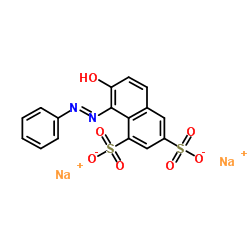Orange G

Orange G structure
|
Common Name | Orange G | ||
|---|---|---|---|---|
| CAS Number | 1936-15-8 | Molecular Weight | 452.369 | |
| Density | 0.80 g/mL at 20 °C | Boiling Point | N/A | |
| Molecular Formula | C16H10N2Na2O7S2 | Melting Point | 141 °C | |
| MSDS | Chinese USA | Flash Point | 14 °C | |
|
Development of a method for the analysis of seven banned azo-dyes in chilli and hot chilli food samples by pressurised liquid extraction and liquid chromatography with electrospray ionization-tandem mass spectrometry.
Talanta 78(1) , 178-86, (2009) An automated, confirmatory and sensitive procedure has been developed and validated for the determination of Sudan (I-IV), Sudan Orange G, Sudan Red 7B and Para Red in hot chilli food samples. The proposed method includes pressurised liquid extraction (PLE) w... |
|
|
Hydrogen peroxide primes heart regeneration with a derepression mechanism.
Cell Res. 24(9) , 1091-107, (2014) While the adult human heart has very limited regenerative potential, the adult zebrafish heart can fully regenerate after 20% ventricular resection. Although previous reports suggest that developmental signaling pathways such as FGF and PDGF are reused in adu... |
|
|
Ethylenediamine modified starch as biosorbent for acid dyes.
J. Hazard. Mater. 172(2-3) , 1665-70, (2009) This work investigated the sorption performance of the ethylenediamine modified starch (CAS) for the removal of acid dyes from aqueous solutions. The influence of pH on adsorption of acid orange 10 (AO10), acid green 25 (AG25) and amido black 10B (AB10B) was ... |
|
|
Purification and characterization of a novel laccase from Coprinus cinereus and decolorization of different chemically dyes.
Mol. Biol. Rep. 40(2) , 1487-94, (2013) Laccase is a blue copper oxidase with multiple copper ions and widely distributed in higher plant and fungi. To date, numerous fungal laccases have been reported by many researchers. In present work, a new laccase gene, named CcLCC5I, from Coprinus cinereus w... |
|
|
Novel amphiphilic polymeric ionic liquid-solid phase micro-extraction membrane for the preconcentration of aniline as degradation product of azo dye Orange G under sonication by liquid chromatography-tandem mass spectrometry.
J. Chromatogr. A. 1349 , 24-9, (2014) A novel amphiphilic polymeric ionic liquid membrane containing a hydrophilic bromide anion and a hydrophobic carbonyl group was synthesized in dimethylformamide (DMF) systems using the ionic liquid 1-butyl-3-vinylimidazolium bromide (BVImBr) and the methylmet... |
|
|
Analysis and testing of biological stains--the Biological Stain Commission Procedures.
Biotech. Histochem. 77(5&6) , 237-275, (2002)
|
|
|
Analysis of sonolytic degradation products of azo dye Orange G using liquid chromatography-diode array detection-mass spectrometry.
Ultrason. Sonochem. 18(5) , 1068-76, (2011) In this paper, seven new sonolytic degradation products of Orange G were found and identified using powerful analytical techniques such as liquid chromatography-electrospray ionization mass spectrometry (LC-ESI-MS), tandem mass spectrometry (MS/MS), and liqui... |
|
|
Complete degradation of Orange G by electrolysis in sub-critical water.
J. Hazard. Mater. 190(1-3) , 1058-62, (2011) Complete degradation of azo dye Orange G was studied using a 500 mL continuous flow reactor made of SUS 316 stainless steel. In this system, a titanium reactor wall acted as a cathode and a titanium plate-type electrode was used as an anode in a subcritical r... |
|
|
Decolorization of an azo dye Orange G in microbial fuel cells using Fe(II)-EDTA catalyzed persulfate.
Bioresour. Technol. 126 , 101-6, (2012) This study constructed a microbial fuel cell (MFC) using Fe(II)-EDTA catalyzed persulfate as the cathode solutions to decolorize Orange G (OG) and harvest electricity simultaneously. Chelated Fe(2+) could activate persulfate to generate sulfate free radicals ... |
|
|
Indirect photometric detection of anions in nonaqueous capillary electrophoresis employing Orange G as probe and a light-emitting diode-based detector.
Electrophoresis 29(14) , 3032-7, (2008) A method based on indirect photometric detection (IPD) in CE employing a blue LED (473 nm) as a light source and the highly absorbing (478 nm) anionic dye, Orange G, as the probe ion was developed for the sensitive analysis of inorganic and organic anions. Th... |